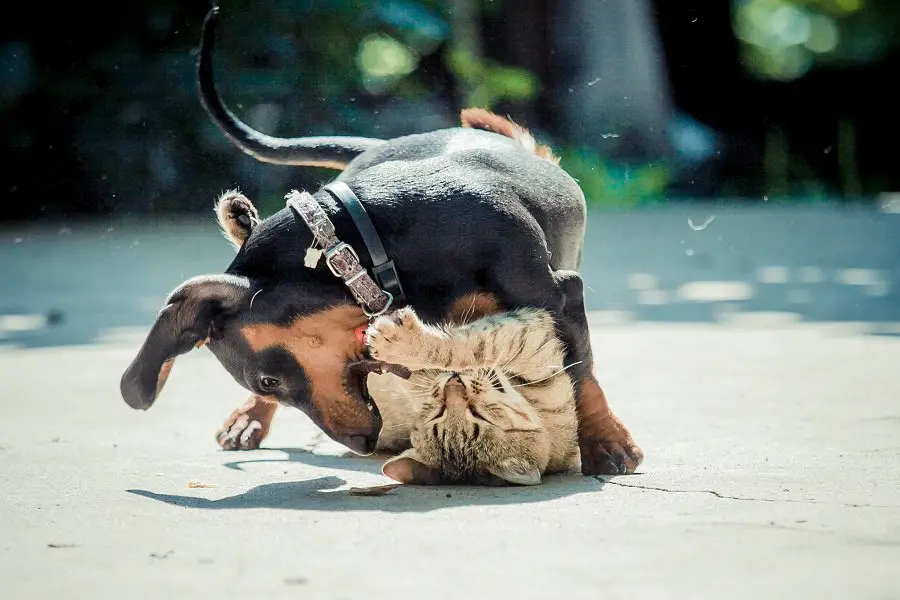Even though most Dachshunds are the same size as cats, it doesn’t necessarily mean they are always going to get along.
Dachshunds are quite stubborn and inquisitive by nature, which sometimes doesn’t suit the introverted personality of a cat.
But the saying ‘fighting like cats and dogs’ does not have to be the case when you introduce your canine to your feline.

Whether your Dachshund and cat get along together is dependent on their personalities, experiences and backgrounds.
If you get your Dachshund as a puppy and your cat is already in the house, they will most likely play nice, as your puppy will accept that cat is boss.
However, if you are introducing an older Dachshund to your cat, there are a few steps to take to ensure you all live happily ever after.
Methods on how to introduce your dachshund and cat together
There are different ways in which you can introduce your Dachshund and cat to each other:

Allow them to meet face-to-face: This method is all about watching the body language of both the dog and cat.
Cats are rarely a threat to a dog, but it can be so the other way around. One person can keep the Dachshund on a lead and another person can hold the cat.
If the cat is not displaying signs of defensiveness, such as a raised back and hissing, then let the cat down to move around.
When your Dachshund is behaving calmly around the cat, you can let it down too and ask them to sit or lie while the cat sniffs around.
If the dog ignores the cat, praise and reward it. If your dog is too fixated on the cat, then try the desensitized method.
The desensitized method: This method is to try and reduce the reaction your Dachshund has to the cat by slowly desensitizing the dog.
Separate both pets and place them in rooms apart from each other with a baby gate across the door.
Make sure all their supplies are in the room with them such as their food, bed, litter box etc.
Let your dog briefly view the cat through the gate and then get the dog to focus on something else, such as a toy or a sound.
If your dog can focus their attention elsewhere, praise them. Let your dog view the cat several times throughout the day, but keep it short.
It can help to feed each pet on either side of a closed door at the same time so that they both associate the other with a food smell or even swap their bedding so they can get used to each other’s smell.
By doing this over a period of time – sometimes hours, days, weeks or months, it depends on the dog -, the dog should lose interest in the cat and become used to the cat being around.
Personality of your dachshund
As every personality and temperament varies from dog to dog, so do the personalities of Dachshunds.
But in general, most Dachshunds have strong personalities. People are often surprised that this tiny dog packs such a punch!
They like to take on dogs a lot bigger than themselves and love being the centre of attention.
They can be quite jealous and tend to make great dogs for a single person or an older person who has time to devote all their love to their fur-friend.
Dachshunds like to be in charge at all times, so it is important that you teach them who is boss from an early age.
Treats work very well with this breed in training as they can be incredibly stubborn.
Patience and being gentle is the key – being harsh may only cause a Dachshund to snap or bite. Dachshunds are notoriously known to bark because they are such alert little dogs.
If a stranger is approaching, they will alert their owner with a high-pitched bark – so again, patience is needed when teaching your little one not to bark.
In terms of exercise, Dachshunds are quite happy with only a little of it.
They like to run around and play games and it is also important that they get this on a daily basis to remain happy and healthy, but they don’t need vigorous hikes.
Do not over-feed your Dachshund though, as they can have weight problems that can then affect their spines among other things.
Warning signs

While the hope is that your Dachshund responds positively to their feline mate, they also may not. Here are some of the warning signs to look for if it is about to go pear-shaped:
-Dachshund launches or shows aggressive behavior towards a quiet and calm cat, or vice-versa, this is a sign that this match will most likely not work out.
-Your cat is displaying behavior of hissing, growling, arching their back and swatting, it means they are going into defense mode and do not feel secure around your Dachshund.
-If your cat stops eating, drinking or using their litter box, they are unhappy.
-After extensive training, your Dachshund can still not stop staring and focusing on the cat, it may mean your dog is not compatible with cats.
Male dachshunds and male cats
Since both male Dachshunds and male cats are both more territorial in nature, this combination requires more work in terms of getting them comfortable with each other.
It is advisable to have opposite genders or two females over two males.
How to cat test a dachshund
If you already have a Dachshund and you are thinking of getting a cat, then it is smart to ‘cat test’ your dog.
Take your Dachshund to a friend’s house where a cat lives and see how your dog reacts to the cat. Is it constantly staring and growling at the cat? Is it barking at the cat?
Is it trying to attack the cat? If it is, these are tell-tale signs that perhaps your Dachshund isn’t suited to live with a cat.
If your dog remains relatively calm, but just curious, this is a good sign!
How to stop a cat attacking your dachshund

Whether it be your cat or a neighbour’s cat that keeps attacking your Dachshund, it is not nice for either animal.
Cats can bite and scratch dogs which can lead to infections. Cats also tend to hiss a lot when they are feeling defensive.
If a dog is constantly making them feel defensive, then they also automatically hiss because they know the dog will leave them alone after that and it is a way for the cat to manage their stress.
You need to calm down your cat and make it feel safer. Here are a few ways to ensure a cat stops attacking your beloved Dachshund:
Manage the situation – if your canine is pestering your feline, your feline will most likely get irritated and attack your poor canine who is probably just looking to play.
When this happens, make sure you have an escape route for your cat so they have a safe place they can run to and ensure that your Dachshund cannot follow.
When you are not around, it is best to keep your cat and Dachshund separated.
Reduce the stress – try and ease your cat’s stress and tension. Some products such as Feliway spray can help calm your cat or soft chews can also help to alleviate the stress.
Direct your cat’s energy – sometimes, cats like to annoy and pounce on the tail of your Dachshund, especially if they are a puppy.
When this happens, distract your cat with a game – perhaps with a piece of string or a ball. The cat will usually play with this instead and leave your Dachshund alone.
Cats can experience ‘re-directed aggression’ which means that if they see something or are triggered by something outside when they are indoors, they can get highly excited and re-direct this energy onto their owner or dog.
When this happens, taking your cat and putting them in a darkened room can calm them down or perhaps it is best they can’t see out of windows if this happens frequently.
If your cat is constantly hissing, make a sudden noise or splash a little water over your cat.
Establishing territories
If you are introducing a Dachshund into a house where a cat already lives, it is important that before that, you make sure your cat knows they have a protected space that is just for them.
Make sure your dog never goes to this area. An ideal space is a cat tree or a bed on top of a book shelf, since cats love to climb upwards.
Keep your cats litter box away from your Dachshund, as cats likes to feel safe when going to the toilet and sometimes dogs like to eat the faeces from a cat.
Always keep a cat and dog’s food bowls separate.
Both animals tend to walk up to the other one’s bowl and eat from it – which can drive the other crazy – especially dogs, who can be very food protective.
Make sure you schedule regular mealtime feeding (no free feeding) and place the dogs bowl on the floor in one room and the cats bowl up high in another room.
Dogs also tend to take cats toys – so make sure this doesn’t happen either.
Exercise can help your dachshund adjust to a cat
It is not just about exercising your dog’s body, but also their mind. Just like humans, they also need to be able to slow down their brains and control themselves – especially around cats.
Stimulate your dog by providing plenty of toys and high-intensity trick training. When you are walking your Dachshund, ask them to sit at every block.
Change up speeds during the walk, as well as directions. If this is not something you have time for, hire a dog walker or sitter.
When your dog is getting an adequate amount of exercise, their interest in pestering your cat will decrease.
Dachshunds and cats can live together harmoniously, but it is up to you to make sure this process happens properly.
It can take a lot of work, but if both of your animals are decent-natured, this usually happens relatively quickly and without fuss.
